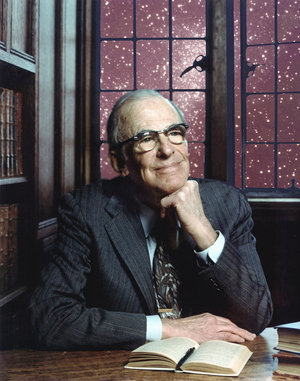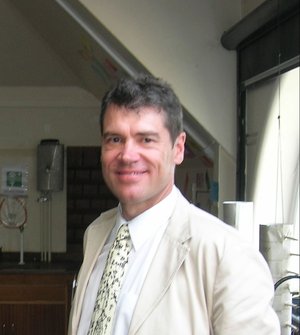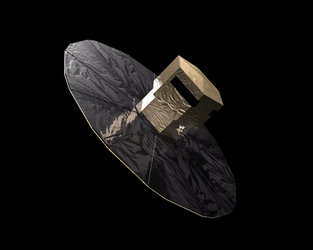Lyman Spitzer: Space telescope pioneer
Amazingly, Lyman Spitzer came up with two revolutionary ideas with practical applications that could change our vision of the world. Even more remarkably, they were in two very different areas of research – interstellar matter and thermonuclear fusion.
Lyman Spitzer Jr. was born on 26 June 1914, to a prosperous family in Toledo, USA. He attended the most prestigious universities of his time: after obtaining a Bachelor's degree in physics from Yale University in 1935, he studied for a year at Trinity College, Cambridge, then obtained a Masters and a Doctorate in astrophysics from Princeton University. As a postdoctoral fellow he then spent a year at Harvard before joining the faculty of Yale University in 1939.
Early recognition
Spitzer married during the Second World War and was a young father at the time of Pearl Harbour. When the USA joined the war, he became a member of the Special Studies Group at Columbia University, carrying out underwater sound research for the development of sonar, a major technological contribution to the Allied war effort.
After the war he returned to Yale briefly as associate professor then in 1947, he was appointed chairman of Princeton's astrophysical science department and a director of Princeton's Observatory.
Although only 33, he requested major changes in the department before accepting the chair. He also asked for his fellow astrophysicist, Martin Schwarzschild, to be named professor. With Schwarzschild’s help, he rapidly turned the department into a leading centre for astrophysical research.
From interstellar dust to plasma physics
Spitzer made one of his first discoveries by comparing elliptical and spiral galaxies; while the first contain old stars and only traces of interstellar gas, the latter contain large amounts of gas and young stars. He thus deduced that the process of star formation is ongoing.
He also worked on the theory of heating and cooling such clouds, and investigated the role of dust grain and the likelihood of pressure equilibrium between the cloud’s components, accurately predicting the existence of a hot halo surrounding the Milky Way.
This interest in stellar formation unexpectedly led to down-to-Earth applications. Spitzer contributed to establishing the physical and mathematical foundations of plasma physics and his book: Physics of fully ionised gases, written in 1956, became a reference for several generations of plasma physicists.
Controlled nuclear fusion
In 1951 Spitzer recommended that the US Atomic Energy Commission commence containing and harnessing nuclear fusion of hydrogen at temperatures exceeding those at the Sun’s surface. To do this he invented a plasma confinement configuration device called a stellarator. Project Matterhorn began in 1953, and led to the foundation of the Princeton Plasma Physics Laboratory headed by Spitzer.
Observatories in the sky
In 1946 Spitzer became part of a 'think-tank' set up by the US Army Air Force to analyse research. His report, 'Astronomical advantages of an extra-terrestrial observatory', proposed the development of large space telescopes, pointing out the many advantages such as access to parts of the spectrum not accessible from the ground.
For nearly two decades he lobbied for this concept until in 1962, a report by the US National Academy of Sciences recommended the development of a space telescope. This led to NASA’s Orbiting Astronomical Observatory (OAO) programme.
Spitzer became prime investigator for the 80-cm telescope for the OAO-3 satellite. Just before lift-off he detected a potential engineering flaw on a drive motor that could cause the instrument to lock and become unusable. He immediately phoned the launch site and a last-minute contingency plan was devised. After launch, the OAO-3 drive motor failed as expected, but the mission was saved, thanks to Spitzer’s timely recommendations.
The Hubble Space Telescope
In 1965, the US National Academy of Sciences established a committee, headed by Spitzer, to define the scientific objectives for a Large Space Telescope (LST). The committee had to fight scepticism from traditional astronomers who feared a reduction in the budgets allocated for ground-based astronomy but the results from OAO-2 and OAO-3 convinced even the most reluctant scientists.
Congress then cut space budgets bringing the LST to a stop in 1974. In 1975, a reduced LST with a smaller primary mirror was proposed, and in 1976 ESA agreed to contribute 15% of the costs in exchange for observing time. After a strong campaign led by Spitzer, the Senate finally restored half the initial budget in 1977.
LST was renamed the Hubble Space Telescope (HST) to honour the astronomer Edwin Hubble, the first to identify galaxies outside the Milky Way. Unfortunately the launch was delayed due to the late supply of some elements and the Challenger tragedy of 1986.
Finally HST was launched in 1990, but soon after a major flaw was detected in the primary mirror and astronomers had to wait until the first maintenance mission in 1993 before they could access its full observation capability.
Spitzer received numerous awards for his achievements, including the Crafoord Prize of the Royal Swedish Academy. He retired in 1982 but remained involved in astronomical and astrophysical research, and a member of the Space Telescope Institute Council, until his sudden death in 1997.
Apart from his interest in the sciences Spitzer was a keen skier and climber, and a member of the American Alpine Club (AAC). After his death, the AAC created a Lyman Spitzer Climbing Grant, awarded annually to expeditions that attempt 'the most challenging routes in the world's great mountain ranges'.
NASA named its Spitzer Space Telescope after him, formerly the Space Infrared Telescope Facility, launched in 2003. The asteroid 2160 Spitzer is also named after him.









